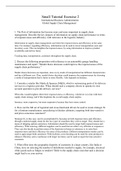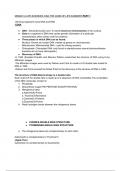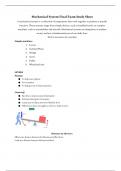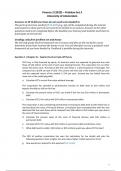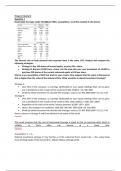Physics for Grade 11 -Part 7
Oscillations
Waves—I
Oscillations
Simple Harmonic Motions
Figure shows a particle that is oscillating about the origin of an x axis, repeatedly going left and
right by identical amounts. The frequency f of the oscillation is the number of times per second
that it completes a full oscillation (a cycle) and has the unit of hertz (abbreviated Hz), where
1 hertz 1 Hz 1 oscillation per second=1 s−1
The time for one full cycle is the period T of the oscillation, which is
Any motion that repeats at regular intervals is called periodic motion or harmonic motion.
However, here we are interested in a particular type of periodic motion called simple harmonic
motion (SHM). Such motion is a sinusoidal function of time t. That is, it can be written as a sine
or a cosine of time t. Here we arbitrarily choose the cosine function and write the displacement
(or position) of the particle in Figure.
,Let’s take some freeze-frames of the motion and then arrange them one after another down
Our first freeze-frame is at t =0 when the particle is at its rightmost position on the x axis. We
label that coordinate as x(m). it is the symbol in front of the cosine, the subscript means
maximum in the next freeze-frame, the particle is a bit to the left of x(m). It continues to move
in the negative direction of x until it reaches the leftmost position, at coordinate x(m).
Thereafter, as time takes us down more freeze-frames, the particle moves back to x(m),
Thereafter, as time takes us down the page through more freeze-frames, the particle moves
back to x(m) and thereafter repeatedly oscillates x and x(m), the cosine function itself oscillates,
the value of x(m) determines how far the particle moves in its oscillations and is called the
amplitude.
counterclockwise by 90degree, so that the freeze-frames then progress rightward with time.
We set time t =0 when the particle is at x(m). The particle is back at x(m) at time t, T (the period
of the oscillation), when it starts the next cycle of oscillation. If we filled in lots of the
intermediate freeze- frames and drew a line through the particle positions, we would have the
cosine.
The quantity ω , is the angular frequency of the motion. To relate it to the frequency f and the
period T, let’s first note that the position x(t) of the particle must (by definition) return to its
, initial value at the end of a period. That is, if x(t) is the position at some chosen time t, then the
particle must return to that same position at time t +T.
Set,Φ=0 we get
………...1
……….2
…………3
We’ve had a lot of quantities here, quantities that we could experimentally change to see the
effects on the particle’s SHM. Figure 15-5 gives some examples. The curves in Fig. 15-5a show
the effect of changing the amplitude. Both curves have the same period. (See how the “peaks”
line up?) And both are forΦ =0. (See how the maxima of the curves both occur at t = 0?) In Fig.
15-5b, the two curves have the same amplitude x(m) but one has twice the period as the other
(and thus half the frequency as the other). Figure 15-5c is probably more difficult to
understand. The curves have the same amplitude and same period but one is shifted relative to
the other because of the different f values. See how the one with Φ=¿ 0 is just a regular cosine
curve? The one with the negative f is shifted rightward from it. That is a general result: negative
f values shift the regular cosine curve rightward and positive Φ values shift it leftward.
Oscillations
Waves—I
Oscillations
Simple Harmonic Motions
Figure shows a particle that is oscillating about the origin of an x axis, repeatedly going left and
right by identical amounts. The frequency f of the oscillation is the number of times per second
that it completes a full oscillation (a cycle) and has the unit of hertz (abbreviated Hz), where
1 hertz 1 Hz 1 oscillation per second=1 s−1
The time for one full cycle is the period T of the oscillation, which is
Any motion that repeats at regular intervals is called periodic motion or harmonic motion.
However, here we are interested in a particular type of periodic motion called simple harmonic
motion (SHM). Such motion is a sinusoidal function of time t. That is, it can be written as a sine
or a cosine of time t. Here we arbitrarily choose the cosine function and write the displacement
(or position) of the particle in Figure.
,Let’s take some freeze-frames of the motion and then arrange them one after another down
Our first freeze-frame is at t =0 when the particle is at its rightmost position on the x axis. We
label that coordinate as x(m). it is the symbol in front of the cosine, the subscript means
maximum in the next freeze-frame, the particle is a bit to the left of x(m). It continues to move
in the negative direction of x until it reaches the leftmost position, at coordinate x(m).
Thereafter, as time takes us down more freeze-frames, the particle moves back to x(m),
Thereafter, as time takes us down the page through more freeze-frames, the particle moves
back to x(m) and thereafter repeatedly oscillates x and x(m), the cosine function itself oscillates,
the value of x(m) determines how far the particle moves in its oscillations and is called the
amplitude.
counterclockwise by 90degree, so that the freeze-frames then progress rightward with time.
We set time t =0 when the particle is at x(m). The particle is back at x(m) at time t, T (the period
of the oscillation), when it starts the next cycle of oscillation. If we filled in lots of the
intermediate freeze- frames and drew a line through the particle positions, we would have the
cosine.
The quantity ω , is the angular frequency of the motion. To relate it to the frequency f and the
period T, let’s first note that the position x(t) of the particle must (by definition) return to its
, initial value at the end of a period. That is, if x(t) is the position at some chosen time t, then the
particle must return to that same position at time t +T.
Set,Φ=0 we get
………...1
……….2
…………3
We’ve had a lot of quantities here, quantities that we could experimentally change to see the
effects on the particle’s SHM. Figure 15-5 gives some examples. The curves in Fig. 15-5a show
the effect of changing the amplitude. Both curves have the same period. (See how the “peaks”
line up?) And both are forΦ =0. (See how the maxima of the curves both occur at t = 0?) In Fig.
15-5b, the two curves have the same amplitude x(m) but one has twice the period as the other
(and thus half the frequency as the other). Figure 15-5c is probably more difficult to
understand. The curves have the same amplitude and same period but one is shifted relative to
the other because of the different f values. See how the one with Φ=¿ 0 is just a regular cosine
curve? The one with the negative f is shifted rightward from it. That is a general result: negative
f values shift the regular cosine curve rightward and positive Φ values shift it leftward.


